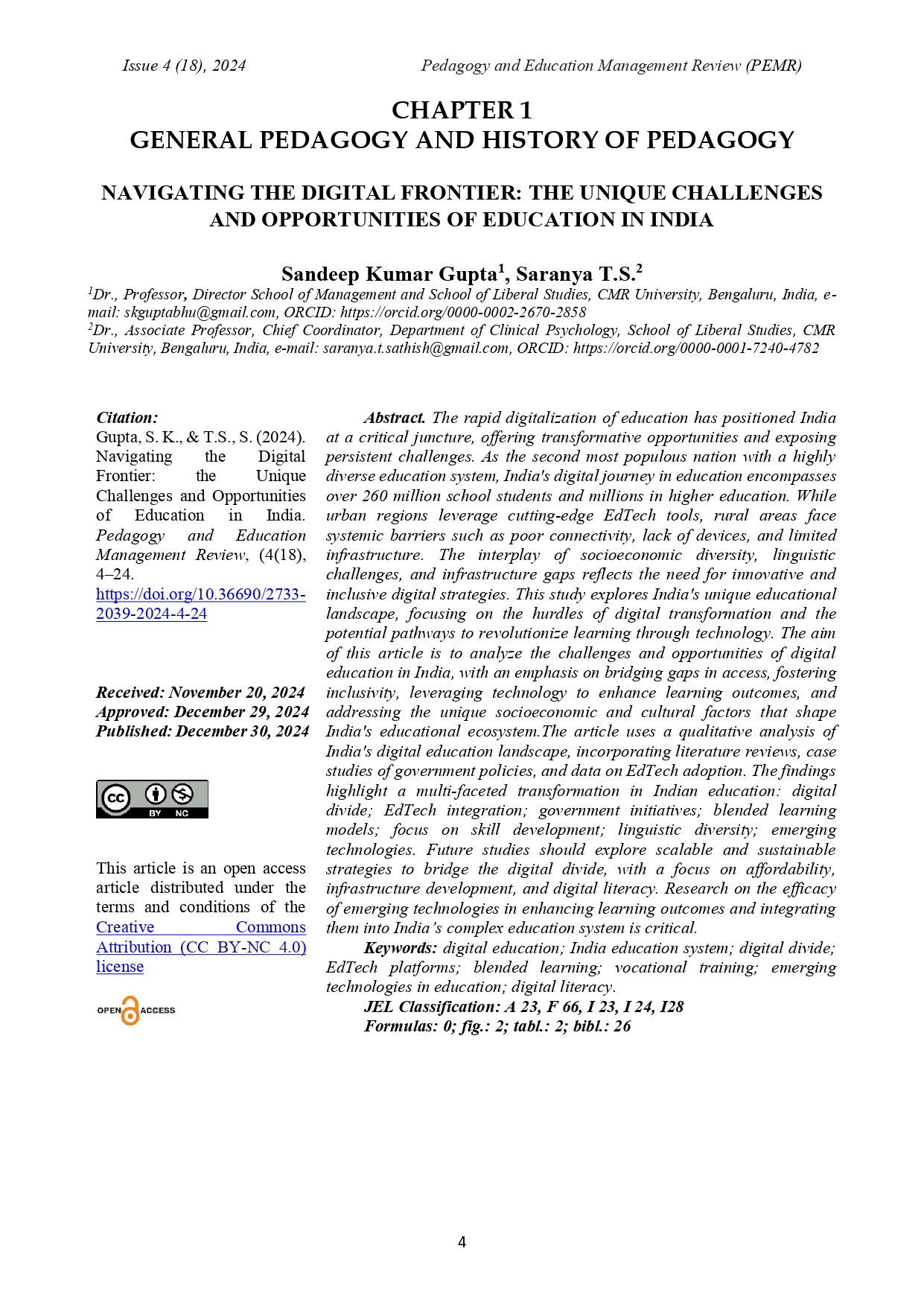NAVIGATING THE DIGITAL FRONTIER: THE UNIQUE CHALLENGES AND OPPORTUNITIES OF EDUCATION IN INDIA
DOI:
https://doi.org/10.36690/2733-2039-2024-4-24Keywords:
digital education, India education system, digital divide, EdTech platforms, blended learning, vocational training, emerging technologies in education, digital literacyAbstract
The rapid digitalization of education has positioned India at a critical juncture, offering transformative opportunities and exposing persistent challenges. As the second most populous nation with a highly diverse education system, India's digital journey in education encompasses over 260 million school students and millions in higher education. While urban regions leverage cutting-edge EdTech tools, rural areas face systemic barriers such as poor connectivity, lack of devices, and limited infrastructure. The interplay of socioeconomic diversity, linguistic challenges, and infrastructure gaps reflects the need for innovative and inclusive digital strategies. This study explores India's unique educational landscape, focusing on the hurdles of digital transformation and the potential pathways to revolutionize learning through technology. The aim of this article is to analyze the challenges and opportunities of digital education in India, with an emphasis on bridging gaps in access, fostering inclusivity, leveraging technology to enhance learning outcomes, and addressing the unique socioeconomic and cultural factors that shape India's educational ecosystem.The article uses a qualitative analysis of India's digital education landscape, incorporating literature reviews, case studies of government policies, and data on EdTech adoption. The findings highlight a multi-faceted transformation in Indian education: digital divide; EdTech integration; government initiatives; blended learning models; focus on skill development; linguistic diversity; emerging technologies. Future studies should explore scalable and sustainable strategies to bridge the digital divide, with a focus on affordability, infrastructure development, and digital literacy. Research on the efficacy of emerging technologies in enhancing learning outcomes and integrating them into India’s complex education system is critical.
Downloads
References
Basu, A., & Chakraborty, S. (2021). Analysis of the National Education Policy 2020: Bridging skill gaps and fostering technological integration in India. Journal of Education Policy and Practice, 15(2), 102–120.
BharatNet Project. (2021). Connecting rural India with broadband. Ministry of Communications, Government of India.
Bhattacharya, R., Singh, M., & Gupta, K. (2021). Impact of COVID-19 on digital education in India: Challenges and opportunities. International Journal of Digital Learning, 12(3), 54–68.
Chandra, S., Kumar, R., & Mehta, P. (2021). Blockchain technology in education: Applications and future potential. Journal of Emerging Technologies in Education, 5(4), 89–98.
Chowdhury, A., Das, S., & Kumar, V. (2020). The surge of EdTech platforms in India during the pandemic: A comprehensive analysis. Education in the Digital Era, 10(1), 23–42.
Das, P., & Mishra, S. (2022). Socioeconomic barriers to digital education in rural India: A critical review. Rural Education Quarterly, 8(1), 34–50.
Garg, R., & Sharma, N. (2020). Linguistic diversity and the digital education divide: A study of multilingual initiatives in India. Journal of Language and Society, 18(3), 67–83.
Iyer, R., & Menon, K. (2021). Artificial intelligence in personalized education: Implications for India. AI in Education Journal, 7(2), 45–60.
Jain, A., & Rao, M. (2021). The rise of online learning platforms: Addressing the skills gap in India. Journal of Lifelong Learning, 9(1), 15–29.
Kapoor, A., & Singh, H. (2021). The role of government policies in promoting digital education in India. Journal of Public Policy and Education, 12(3), 78–92.
Kulkarni, P., Verma, S., & Shah, R. (2022). Realigning skill development programs with industry demands: Challenges and strategies. Skills and Employment Quarterly, 6(1), 49–65.
Kumar, A., Sharma, R., & Patel, N. (2021). Bridging the digital divide: An analysis of connectivity and literacy challenges in rural India. Digital Inclusion Journal, 11(2), 34–56.
Malhotra, D., & Desai, P. (2022). How the pandemic accelerated innovation in Indian education technology. Tech and Society, 14(2), 45–63.
Mehta, R., & Joshi, V. (2022). EdTech platforms in India: Challenges in scalability and inclusivity. Educational Innovations Journal, 8(1), 21–36.
Ministry of Electronics and Information Technology, India. (2021). Digital India: Transforming the nation through technology. Retrieved from https://www.digitalindia.gov.in.
NASSCOM. (2022). EdTech: The new frontier in education. Retrieved from https://www.nasscom.in.
National Education Policy 2020. (2020). Government of India. Retrieved from https://www.education.gov.in.
Patra, B., & Nayak, S. (2020). Digital inequities in Indian education: A socio-economic perspective. Education and Society Journal, 14(3), 76–89.
Raman, S., & Singh, J. (2022). Evaluating the impact of digital education policies on rural communities. Journal of Policy Impact Studies, 9(4), 67–82.
Ravi, K., & Nair, S. (2020). The blended learning model in India: Adoption, challenges, and future scope. Hybrid Education Review, 4(3), 23–40.
Reddy, S., Rao, A., & Bhatt, M. (2019). Addressing linguistic barriers in digital education: Insights from India. Journal of Cultural and Educational Studies, 10(2), 56–72.
Saxena, A., Gupta, S., & Rao, R. (2021). Flipped classrooms and hybrid learning in Indian higher education. Innovations in Teaching and Learning, 9(1), 12–28.
Sharma, V., & Gupta, P. (2021). Redefining learning experiences: The role of EdTech platforms in India. Journal of Educational Technology, 16(1), 29–42.
Singh, T., & Patel, R. (2020). Digital literacy and education in India: A critical analysis of current trends. Digital Learning Quarterly, 8(4), 45–58.
UNESCO. (2021). The future of education and technology in India. Retrieved from https://www.unesco.org.
Varma, P., & Dutta, K. (2022). Virtual and augmented reality in education: Transforming the Indian classroom. Journal of Advanced Learning Technologies, 11(3), 34–47.







